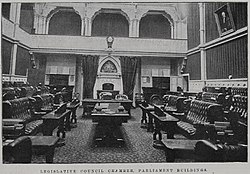New Zealand Legislative Council | |
|---|---|
| Type | |
| Type | Upper house of the General Assembly of New Zealand[a] |
| History | |
| Established | 1853[b] |
| Disbanded | 1 January 1951[c] |
| Preceded by | New Zealand Legislative Council (1841–1853) |
| Leadership | |
| Elections | |
| Appointed by governor/governor-general | |
| Meeting place | |
 The original plenary chamber, photographed in 1899 | |
| Parliament House, Wellington | |
| Footnotes | |
 |
|---|
|
|
The New Zealand Legislative Council (Māori: Whare o Runga, lit. 'Upper House')[3] was the upper house of the General Assembly of New Zealand between 1853 and 1951.[2] An earlier arrangement of legislative councils for the colony and provinces existed from 1841 when New Zealand became a colony; it was reconstituted as the upper house of a bicameral legislature when New Zealand became self-governing in 1852, which came into effect in the following year.
Unlike the elected lower house, the House of Representatives, the Legislative Council was wholly appointed by the governor-general. The New Zealand Constitution Act 1852 had authorised the appointment of a minimum of ten councillors. Beginning in the 1890s, the membership of the upper house became controlled by government of the day. As a result, the Legislative Council possessed little influence. While intended as a revising chamber, in practice, debates and votes typically simply replicated those in the lower house. It was abolished by an Act of Parliament in 1950, with its last sitting in December 1950.
The Council's chamber is no longer utilised as a debating chamber, but it is used for certain ceremonial functions, such as the speech from the throne.
- ^ Scholefield 1950, p. 68.
- ^ a b "Legislative Council abolished". Ministry for Culture and Heritage. Archived from the original on 25 April 2019. Retrieved 25 August 2017.
- ^ "Whare o Runga - Te Aka Māori Dictionary". maoridictionary.co.nz. Retrieved 12 February 2023.